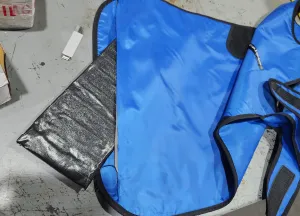CINCINNATI—Over the past three weeks U.S. Customs and Border Protection (CBP) officers in Cincinnati seized ten shipments of narcotics being moved from and through the United States to countries around the world. Combined, the shipments held nearly 100 pounds of dangerous and illegal narcotics: about 74 pounds of cocaine and 24 pounds of methamphetamine, which could have a cumulative U.S. street value of up to $1,214,640.
On October 17, CBP Narcotics Detector Dog (NDD) “Bico” alerted to a socket set enroute from California to New Zealand. Officers conducted a physical inspection and found the casing around the tools had been hollowed out and filled with methamphetamine.
A few days later, on October 25, officers held a shipment of tea sets originating in Covina, California and destined to Australia. The tea sets were housed inside two suitcases lined with felt, under which were blue corrugated inserts that were taped closed and leaking white powder. Officers tested the powder and found it to be methamphetamine.
CBP NDD “Betty” alerted to a shipment of racing jackets the next day. The clothing was coming from Canada and headed to Australia. Officers found thin plastic packets of cocaine within the lining of the jackets. Shortly thereafter, officers inspected a cosmetic machine containing cocaine, also moving from Canada to Australia.
During the next shift, CBP NDD “Otos” sniffed out a shipment from California containing a marble chessboard with a large base. In the base of the chessboard, officers found a cavity full of white powder that tested positive for cocaine. The chessboard had been destined to Australia.
On October 28, officers inspected a shipment from California that was leaving the country for Italy. Although the shipment contained puzzles and a children's book, packages of white crystals were tucked inside the puzzle boxes and within a cavity in the book. Tests indicated the crystals were methamphetamine. The same day, officers stopped a shipment headed to Hong Kong from Barbados because of anomalies during an x-ray exam. Cocaine was packed inside the walls of a speaker amplifier within the package.
The following week, “Bico” tracked down another illicit California shipment destined to Australia. The package contained a lead apron showing density abnormalities during an x-ray inspection. When officers took a closer look, they found a removable black tape-wrapped package containing layers of vacuum sealed bags and a hard, white substance that tested positive for cocaine.
Four days later, officers found methamphetamine hidden in water filters in transit from New Jersey to New Zealand. The following day, they extracted ten packages of cocaine from a hospital bed moving from Alberta, Canada to Australia.
“CBP is responsible for ensuring that all goods entering and exiting the United States comply with all applicable U.S. laws and regulations,” said Cincinnati Port Director Richard Gillespie. “Exporting is very important to the U.S. economy, and our officers will continue to ensure legitimate trade continues while using their training and skills to prevent dangerous narcotics from entering or exiting the country.”
Cocaine and methamphetamine are Schedule II substances under the Controlled Substances Act. Their abuse can lead to many adverse health consequences including cardiac arrhythmias, heart conditions, cardiac arrest, convulsions, stroke, and death.
“CBP implements a multifaceted approach to combat the flow of illegal narcotics, including collaboration and enhanced intelligence sharing with other agencies and foreign partners,” said Director of Field Operations for the Chicago Field Office, LaFonda D. Sutton-Burke. “The outstanding work done by our officers and canine partners to identify and seize 98 pounds of deadly drugs makes the world a safer place.”
CBP conducts operations at ports of entry and export throughout the United States, and regularly screens inbound and outbound international passengers and cargo for narcotics, weapons, and other restricted or prohibited products. CBP strives to serve as the premier law enforcement agency enhancing the nation’s safety, security, and prosperity through collaboration, innovation, and integration. On a typical day in Fiscal Year 2021, CBP seized 4,732 pounds of drugs at ports of entry and export across the nation.
Follow CBP on Twitter @CBPChicago and @DFOChicago.


